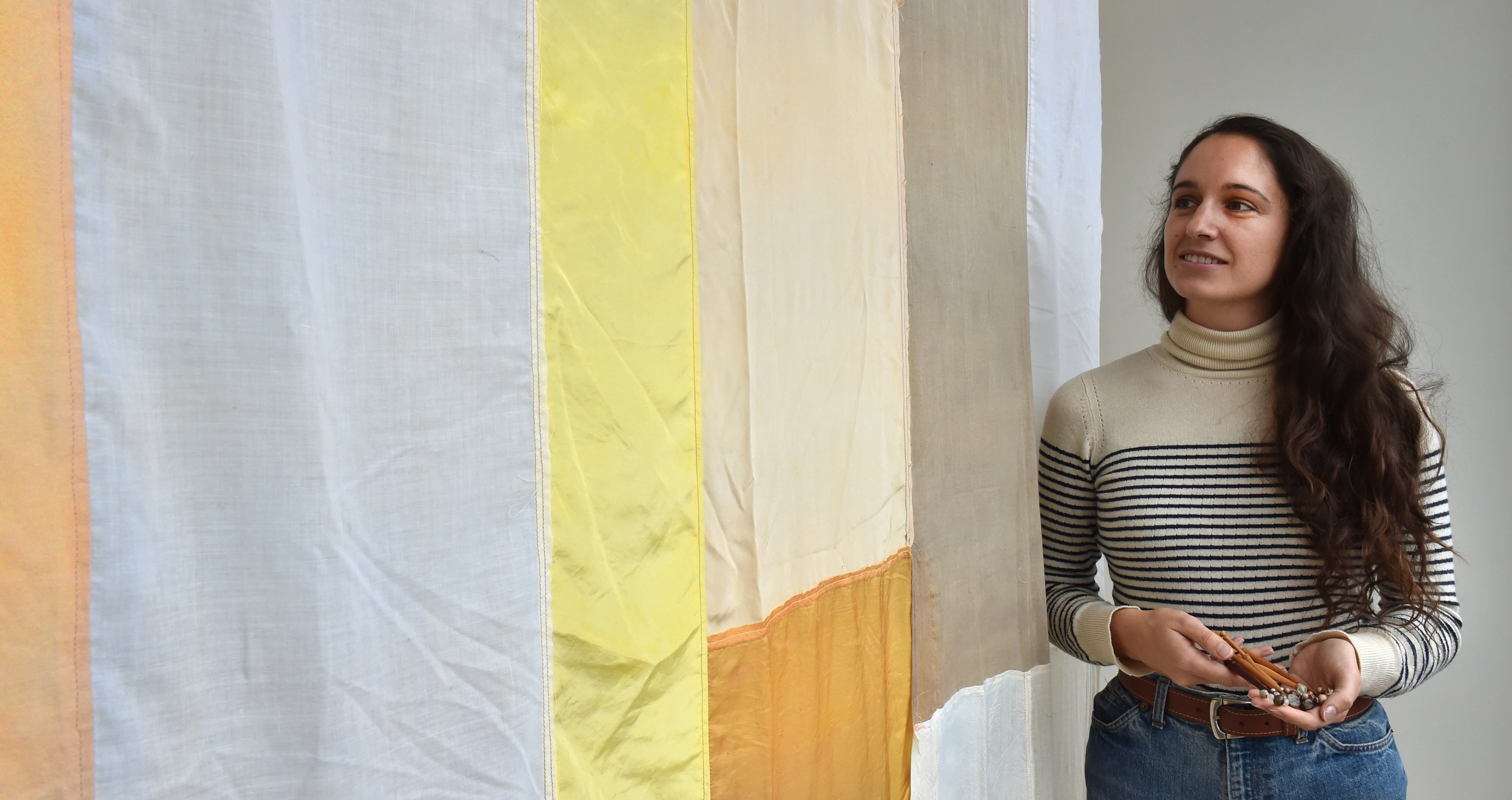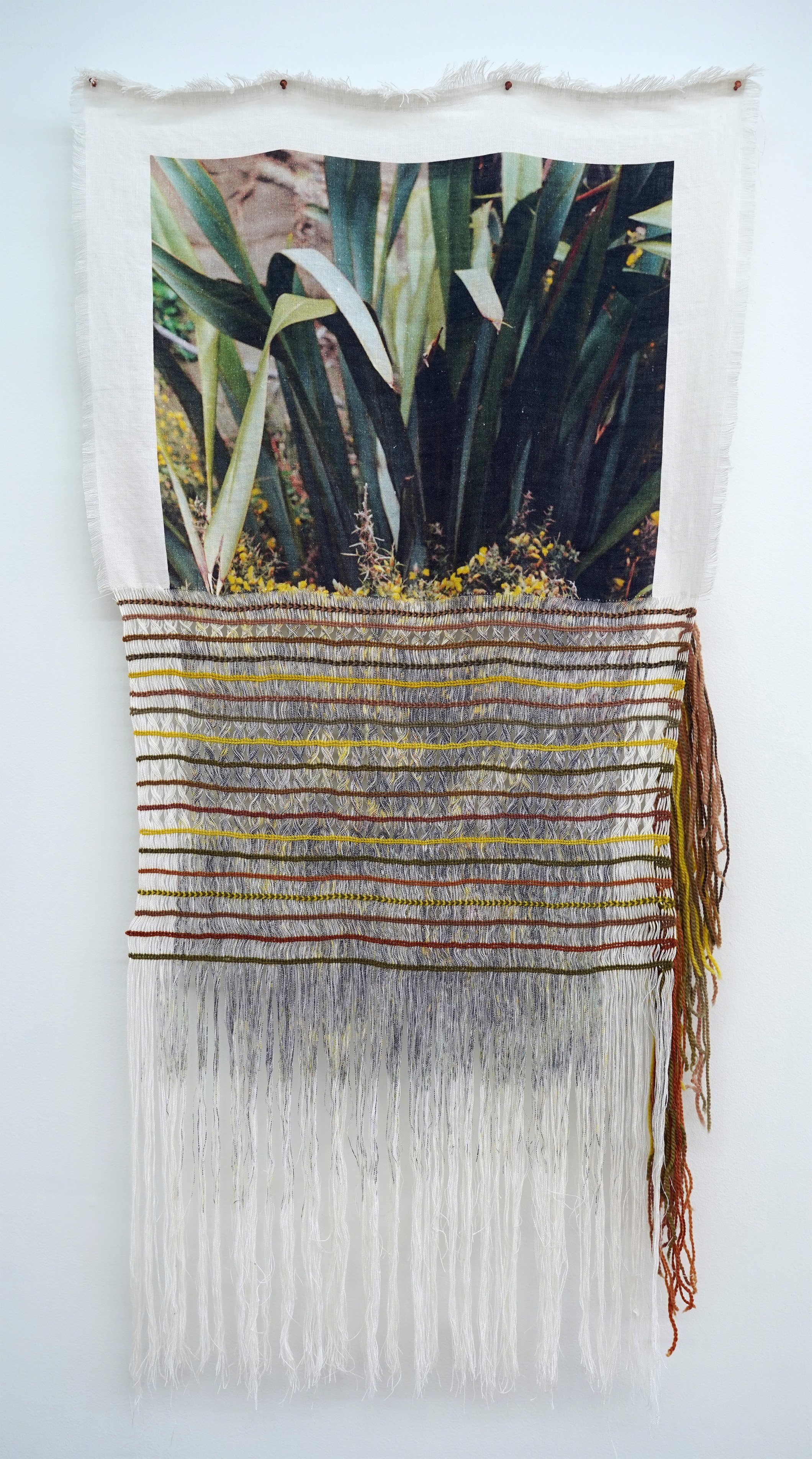
Wherever Auckland artist Arielle Walker goes so does a small pink clear plastic container held together by a hair tie.
In it is a collection of wooden bobbins. Hand-turned by her uncle and given to her by her Nana Maire they are as special to her as a piece of heirloom jewellery.
"They’re not something I could ever imagine not having with me."
The bobbins are used to make bobbin lace and Walker’s strongest childhood memory of her crafty Nana is of her making the lace.
"When I was younger I’d get to play with the bobbins a little bit. She always had something on the go."
When she was about 12 years old, her Nana gave her a set of bobbins, including one of her own, suggesting she create her own beaded spangles on their ends.
"The idea was I’d eventually learn bobbin lace making. I was really excited to try but it was super intimidating. You can see my early spangles with the teenage preoccupation with sparkly butterflies."
While always a treasured possession, it was not until Walker started on her most recent body of work that she got the bobbins out again.
"It made me think about what my Nana and Grandmama and mother did."
Her latest work focuses on the relationship between storytelling and traditional crafts passed down over generations, referencing her grandmothers’ family lines, and looks towards her ancestral homelands, particularly Taranaki, Scotland, and Ireland.
"It came from this space of being surrounded by textiles and I was thinking about my whakapapa, in particular my Nana and Grandmama and I realised I really need to finish the bobbins so they’d be ready to work with."
She started making new beads for them using Taranaki clay and stones and pearls from her late Grandmama Faith.
"I’m trying to bring some of the places from my whakapapa together in this one piece."
They are still a work in progress but she will display them as part of her exhibition "distance rewoven from the roots to the stem" when she is in the gallery.
"I wanted to finish them before starting a piece. All this work is leading up to eventually being brave enough to give the bobbin lace a go."
Her Nana is now no longer able to make bobbin lace and the detailed embroidery she used to.
"I feel like I’m now having to carry on what she fostered in me, that love of making.
"A lot of my practice is about carrying on the story from along my family lines."

"I have a wooden castle my father carved for me and my mother used to always make wonderful coloured pictures for me. If I was going to the doctor she’d make this picture for me to find all the different things. The way of getting through things was through art.
"Storytelling art and making have always been connected from the beginning, so that is just something I’ve kept going."
There was never a particular decision to make it a career. While Walker says she could have pursued interests in music, she could not imagine leaving art behind.
"No-one was surprised when I went to art school."
Walker has looked back at her heritage to find the roots of her family’s creativity.
"The more I’m learning about it seems that thread of storytelling and weaving in different ways comes through in those lines. That and people in direct contact with the land as well. I think place is particularly important."
Her father grew up in Taranaki and his family is still based there.
"We’d go down quite regularly, summers were bouncing back and forward between the two.
"It feels weird when I’m away from the west coast for too long."
The landscape of those places and family is also closely interwoven into her work.
"I was looking at plants, particularly those used for healing and also for their dye properties, which are from what I think of as my ancestral homelands, Taranaki particularly but also on the pakeha side is Scotland and Ireland."
Looking closely at some of the handmade beads in her bobbin spangles, the black sand of the west coast can be seen. Others are made from seaweed and pumice from Oakura in Taranaki or from river stones gathered from Tongaporutu Beach.
Walker foraged as she walked along the coastline picking plants that can be used to make dye, such as gorse, kanuka, harakeke, lichen and tanekaha.
She then used those dyes to colour handed-down silk, cotton muslin and linen and sewed them together into one large patchwork blanket with her Grandmama’s threads to create first soft light of the rising sun.
"I wanted to bring together the plant traditions of those places as a way to, I guess, to sort of bring together those strands in one place. A lot of the dyes are from Taranaki too, like gorse which is an invasive plant from Scotland but it was gathered around Taranaki."
When she had completed the blanket she took the piece back to the coast.
"We were really lucky, the wind picked up just as I was bringing it out of the car so it became this beautiful, flowy, fluttering thing and we caught that on film.
"The colour’s completely by chance - they could have come out any colours. You don’t always know when you see a plant what it’s necessarily going to look like - but it looked exactly like the cliffs and the colours of the sand, the greys that look like the rocks and sand and the gold and the oranges of the cliff.
She finds it fascinating how the colours that come from the plants flow right back into the landscape they came from.
"It represented the land immediately, I’m always amazed at how these materials have the ability to do that.
"Sometimes with works it’s just about seeing what the plants have to give. Sometimes the colour is there for only a few weeks, other times for decades."

She attends group sessions with her on traditional weaving practices.
In 2018 she did residencies in Scotland and Iceland, again learning traditional textiles practices including natural dying from those countries.
In Iceland there has been a movement revitalising practices around plant dyes, she says.
"I’m definitely very much a learner. It showed the importance of learning those traditions."
In Ireland and Scotland yarrow is regarded as a healing herb and also creates a yellow dye.
"This is where my love of a story comes in. Yarrow’s Latin name comes from the idea that it was used by Achilles to heal soldiers on the battlefield. Some of these plants have been known for their properties for thousands of years.
"In some places the knowledge has been lost and in others it hasn’t."
Goats’ beard lichen is another that surprises with the vibrant orange dye it produces, she says.
"This is where it is amazing. Our ancestors worked this out. I was able to find people who had written about it but someone had to work that out in the beginning."
She enjoys that her work takes her into the great outdoors.
"It’s a way to become grounded in a place and learning the plants, introducing yourself to them."
Another work features a photograph of the Taranaki harakeke and gorse she was harvesting, printed on to hemp fibre then unravelled by hand.
Walker then weaved wool dyed in the gorse, kanuka, harakeke, lupin and tanekaha through the strands.
"This is the whatu that Whaea has been teaching as I’ve been learning. That’s not a tradition that has been passed down. I’m just learning, so every row took an hour."
All of the fabrics used in her work are found or passed down to her. In embodying my roots, skin and leaves she has used vintage and woollen blankets.
"My dad said you haven’t cut up Nana’s good blankets have you? I hadn’t. So they’ve all had another life beforehand."
The works in her latest exhibition she does not see as finished.
"They are ongoing. They can be quite labour intensive in the moment but then stretch out over time as well."
One of those works is the blanket she hand knitted in the Print o’ da Wave Shetland lace pattern. The wool was hand spun while Walker and her partner’s sister talked.
"We have Shetland heritage too. It’s a beautiful pattern that references the sea as these other works do, by being from the coast.
"I was interested in this idea of lace and seeing if it could become something useful. Hence the title If I knit enough lace into blankets we can keep warm for generations."
Creating in conversation is also important to Walker.
"That is how textile practices have always been, people, particularly women, sitting around in a space, sharing stories and conversation while making."
Alongside her textiles, Walker is showing a short film, shot by Emily Parr, featuring first soft light of the rising sun fluttering on the beach and her poetry being read.
"It’s not that I don’t think the works can stand alone but I wanted to tell the stories of the plants I was using, so there is a longer spoken version which plays with the silk work, but there are a few shorter parts I like to give to people."
While not convinced her writing is poetry, that is what she is calling it for the exhibition. She has always been around storytelling and had not realised until a few years ago that what she was writing was poetry.
"I’ve always been a bit more nervous about the words than the making. All my ancestors come from storytelling traditions so poetry ties into that.
"I don’t think of myself as a poet."
She feels that she has been given so much to be able to do the work that she likes to give something back to those who visit.
"These are little poem pieces that tell some of the stories behind the plants used. The full poem goes through almost all of the plants that have been used with a focus that they are healing plants."
A lot of her practice has been trying to reconcile and to heal what Walker sometimes feels is quite a fragmented whakapapa.
"There are sometimes tensions between the different strands between Pakeha and Maori and what that means. By talking about the plants they almost started becoming able to be metaphor for ways of navigating through things."
She also emphasises that none of the works in the exhibition come solely from her.
"When I was first learning to whatu I was saying, "wow, I’m really good at this", and then I started messing it up massively and I thought "it’s not me doing this". It’s those generations before me working through me."
Being able to exhibit the works at Blue Oyster is a dream come true for Walker.
"I have always wanted to exhibit here. I’ve followed their programme ... It always seemed like a space that made exciting work and supported artists in projects."
While she had not visited Dunedin before, when her latest body of work started coming together, Blue Oyster was the only gallery she applied to.
"It’s the only one I wanted to be in. It’s been really interesting learning more about the Taranaki connection here, which I have to admit I hadn’t really known about at all."
A verse from one of Arielle Walker’s poems
Make the aho from all you have gathered here
harakeke and heather, kanuka and alder,
manuka and elder
thistle bite and docken soothe
simmered kawakawa and yarrow
the colours that reveal their roots
and yours, too
TO SEE
‘‘distance rewoven from the roots to the stem’’
Arielle Walker
Blue Oyster Art Project Space, until May 15. Korerorero, May 12-13, noon-2pm.












